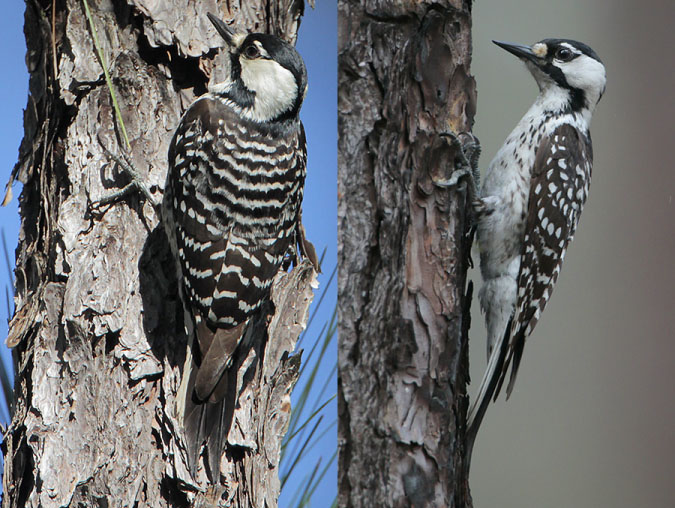The Red-cockaded Woodpecker is a small woodpecker with a straight, short bill. A lot of their original habitat has been lost due to logging, so your best bet for finding this bird is in national forests and national wildlife refuges that manage and protect large areas of habitat.
Because it’s an endangered species, some of their known nesting sites may be off-limits, and those regulations should be respected.
On this page
Identification
Despite their name, Red-cockaded Woodpeckers are mostly black and white. They have bold black malar stripes and a large, bright-white cheek patch.
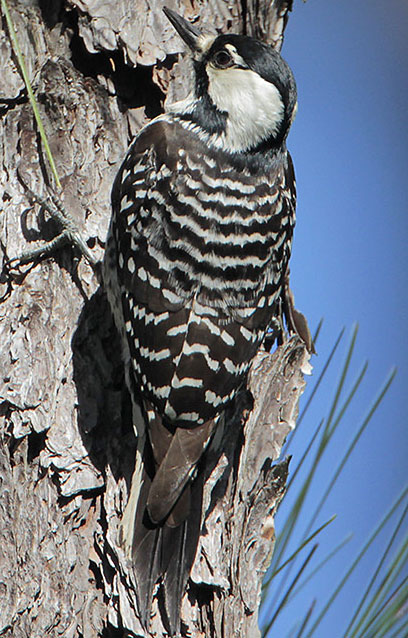
Males have a red streak that’s nearly invisible on the upper border of the cheek. Their backs have strong horizontal black-and-white bars. These birds are 7.9 to 9.1 inches long, weigh 1.5 to 1.8 ounces, and have a wingspan of 14 inches.
Female Red-cockaded Woodpeckers look very similar to male Red-cockaded Woodpeckers. Females lack the red streak that’s nearly invisible on the upper border of the cheek that males have. They are roughly the same size.
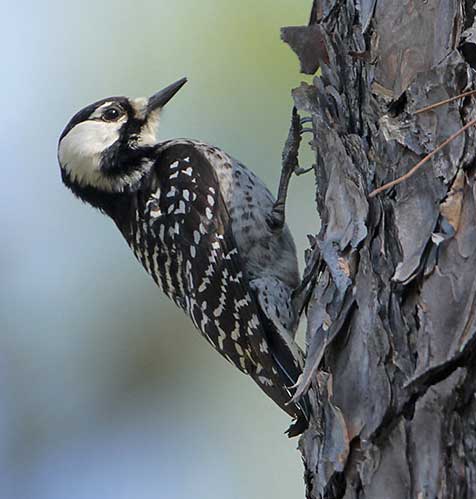
Female Red-cockaded Woodpecker. © Greg Lavaty
Food
Red-cockaded Woodpeckers consume insect eggs, larvae, adults, and other arthropods found in pine trees on or under the bark. Their prey includes termites, ants, southern pine beetles, centipedes, and wood roaches.
In addition, they’ll sometimes consume fruits and seeds, including wild cherries, pine seeds, pokeberries, magnolia berries, grapes, poison ivy berries, blackgum berries, and blueberries. Male Red-cockaded Woodpeckers primarily forage on upper tree trunks and branches, while females forage mainly on the trunk, below the branches.
These birds generally forage in groups and can even be joined by songbirds like Brown-headed Nuthatches and Eastern Bluebirds. This is especially true in the winter.
Nesting and Eggs
Red-cockaded Woodpeckers place their nests in the breeding male’s roost cavity. In most cases, nests are placed in pine trees that are alive.
Cavities that have been created recently tend to have resin flowing from the holes the woodpeckers drill just below the entrance of the nest. Nesting cavities can be more than 100 feet off of the ground and usually face to the south or west.
Nesting cavities have various shapes and sizes according to the size of the heartrot in the tree and will grow over time. The entrance measures 2 to 3 inches wide, and the interior measures about 3 to 4 inches wide at its widest point. There is no nest in the cavity, but it’s often lined with wood chips left behind from excavation.
The clutch size varies from 2 to 5 eggs. They incubate the eggs for around 10 or 11 days, after which, the young babies stay in the nest for 26 to 29 days.
Current Situation
Red-cockaded Woodpeckers were once common in the southern portions of the U.S., and their population held pretty steady between the late 1960s and 2019. However, their current population is a fraction of what their numbers used to be.
According to the IUCN Red List, there are around 19,000 mature individuals, which marks them in the near threatened area.
Most of the large populations that remain are on federally protected lands. Because these birds depend on old-growth pine forests in the south for habitat and food, they’re vulnerable to forest fragmentation, clearcutting, fire impression, and conversion of pine forests to slash pine forests.
As a result, different measures of conservation are being used, including constructing artificial cavities, using metal plates to control the size of cavity entrances, moving young females to groups that lack a breeding female, and habitat management that preserves trees suitable for nesting cavities and roosting as well as large areas of foraging habitat.
The Red-cockaded Woodpecker lives in pine forests in the southeastern portions of the United States.
They particularly like longleaf pine forests. This kind of habitat used to be extensive but almost disappeared completely during logging in the 1900s. These birds are commonly found in mature slash, loblolly, pitch, shortleaf, pond, and Virginia pine forests.
Facts
- These woodpeckers nest and roost specifically in live pines. These live pines are commonly infected with red heart fungus. They prefer trees with this disease because it softens the wood and makes excavating cavities easier.
- This species of woodpecker prefers to drink fresh water from cavities on branches, needles, or leaves.
- The Red-cockaded Woodpecker lives in small family groups and is a cooperative breeder. Family groups usually have 1 breeding pair and multiple helpers. The helpers are usually sons from previous breeding seasons, and they assist in feeding, brooding, and incubation.
- If no cavity is available, Red-cockaded woodpeckers sometimes sleep under a tree limb or other protected areas.
- The oldest recorded Red-Cockaded Woodpecker lived to be at least 16 years and 1 month old. It was found in North Carolina in 1999.
Part of our Black & White Birds Collection
Similar Species
The Red-cockaded Woodpecker has features that are similar to other bird species. Here are some similar species:
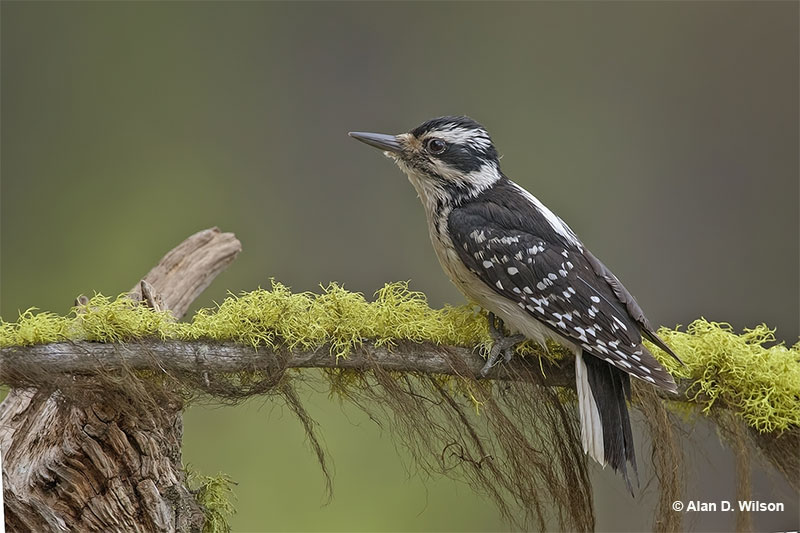
Downy Woodpecker
The Downy Woodpecker and Red-cockaded Woodpecker have some distinct variations in their appearance.
Downy Woodpeckers do not possess the prominent white cheek patch that Red-cockaded Woodpeckers have.
Additionally, Downy Woodpeckers have plain white bellies, while Red-cockaded Woodpeckers have white bellies with black spotting along the sides.
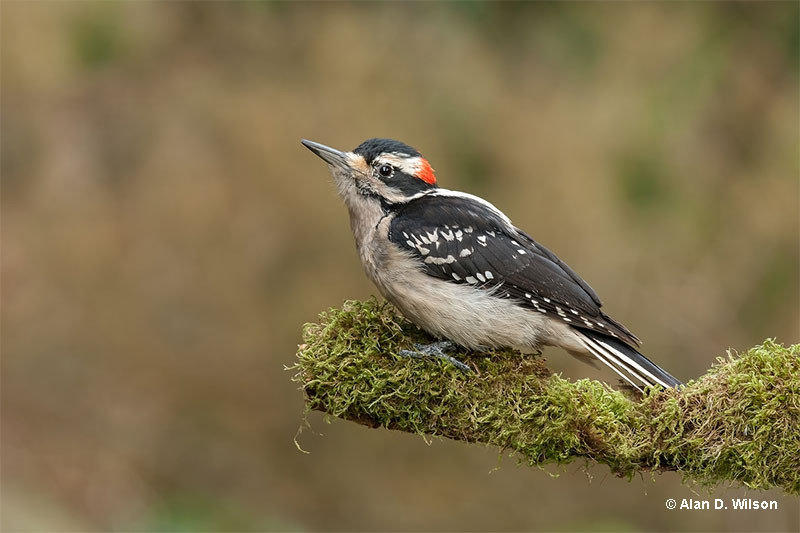
Hairy Woodpecker
Compared to others, Hairy Woodpeckers look even more similar to Red-cockaded Woodpeckers than Downy does.
Red-cockaded Woodpeckers have barring on their plumage and feature a prominent large white cheek patch.
In contrast, Hairy Woodpeckers have a sizable white stripe running down their backs.
Downy vs Hairy Woodpeckers (What are the differences?)
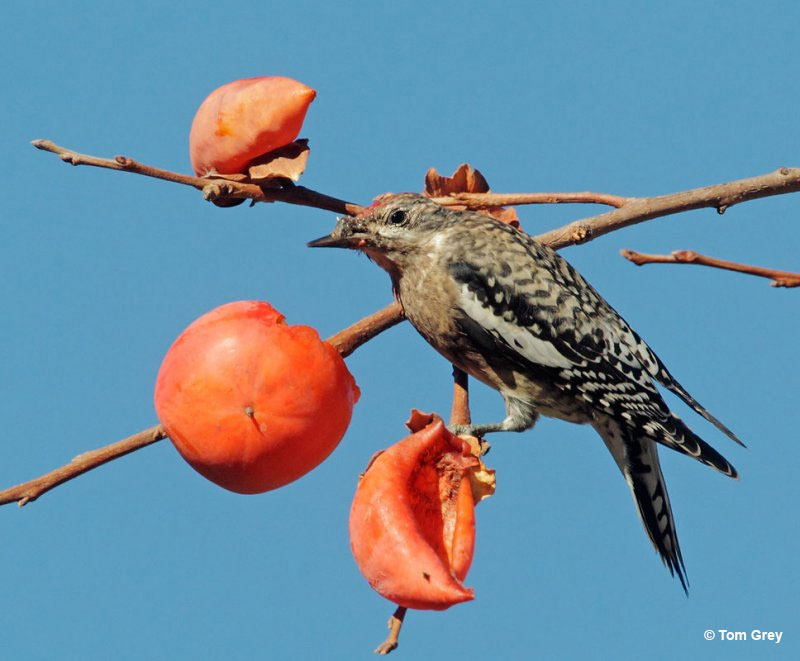
Yellow-Bellied Sapsucker
When taking a closer look, Yellow-bellied Sapsuckers are a little bit bigger than Red-cockaded Woodpeckers.
Furthermore, they don’t have the large white cheek patch that Red-cockaded Woodpeckers do, and Yellow-bellied Sapsuckers have a prominent amount of red on their face and lack the black and white barring on the back.
Frequently Asked Questions
Is the Red-cockaded Woodpecker rare?
Yes, Red-Cockaded Woodpeckers are rare. They’re an endangered species and have a breeding population of only 19,000.
How do you identify a Red-cockaded Woodpecker?
Male and female Red-cockaded Woodpeckers look very similar to one another. They have primarily black and white plumage. These birds have striking black malar stripes and a prominent, large white cheek patch.
It’s worth noting that females do not have the almost invisible red streak on the upper edge of the cheek, which is characteristic of male birds. Furthermore, their backs have distinctive horizontal black-and-white bars, which creates a striking visual pattern. They’re the same size and length and have the same wingspan as breeding males. They also weigh the same amount.
What trees do Red-cockaded Woodpeckers live in?
The Red-cockaded Woodpecker lives in pine forests in the southeastern portions of the United States. They particularly like longleaf pine forests. These birds are commonly found in mature slash, loblolly, pitch, shortleaf, pond, and Virginia pine forests.
Why is the Red-cockaded Woodpecker important?
Red-cockaded Woodpeckers are essential because they’re a species that other wildlife depends on. These birds excavate nesting cavities, which will later provide nesting habitat for other species, including Eastern Bluebirds, Red-headed Woodpeckers, and mammals like the southern flying squirrel.

